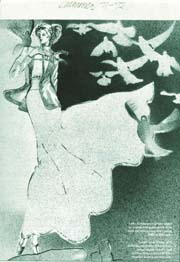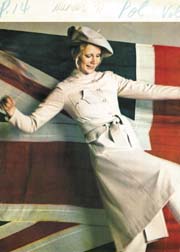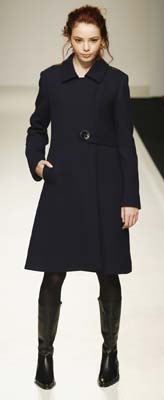|
fashion: feature
 What legends are made of
What legends are made of
Marilyn Sainty is one of the matriarchs
of New Zealand fashion, as Sylvia Giles discovers Excerpted from
issue 22 of Lucire
THERE ONCE was a time when New Zealand
didn’t have the burgeoning fashion industry it can now boast. Clothing
was expensive and limited in choice, town was shut at 11 P.M.
on a Friday night, and a fashion magazine was hot property. At this
time in the ’60s, Marilyn Sainty was beginning her career in a boutique
in Hamilton. As a tentative industry, fashion is a fickle mistress,
but Sainty has seen the opening up of the economy, the demise of
local production, and full circle to the recent boom of fashion
designers we see today.
She then moved to Sydney, cutting her teeth working
for a manufacturer for two years before starting the boutique, Starkers,
in the city with two other women that ran for five years. After
her jaunt in Sydney, she returned in 1974, and although she had
planned to dash back off overseas, stayed and began to cultivate
her self-titled clothing range.
Large manufacturers that generally reproduced
garments from overseas’ department stores primarily made up the
scene at that time. Noticing that there were no good T-shirts in
stores, she starting using knits to produce both them and dresses,
growing from there. ‘In those days I would make what I liked, put
it in a box and send it to the different stores, working in season.’
Although the fashion on offer was limited, Sainty
maintains that this was not due to any lack of interest. ‘Time and
memory are quite distorted for me now. My main memory, extending
back into childhood, is that there was always a strong interest
in fashion in New Zealand that continues. The changes that have
occurred over the 40 years that I have been making clothes seem
unremarkable, in that everywhere has become more sophisticated in
the area of design and there has always, it has seemed to me, to
be an ebb and flow of talent. The audience is more affluent and
on the whole more interested.’
The Scotties venture was born in 1976, with a
store on Queen Street in Auckland, stocking Sainty’s own work alongside
other local labels such as Jane Cross and Blooms. Since the 1980s,
New Zealand has lead the way in terms of free trade, with the removal
of tariffs that has been responsible for the influx of cheap clothing
made in countries like Red China. While ‘Rogernomics’ may continue
to be a dirty word for many, this has made fashion affordable, one
could argue, even possible. ‘What has changed since the ’80s and
the opening up of the economy is, of course, the leisure activity
of shopping. There is so much more to buy and we contribute to that.’
But aside from any humanitarian issues for the
country of manufacture, this can often mean death to local industry
as well. But that is without the help of a niche, of course, and
Sainty’s clothes have always displayed an adventurous sense of sophistication.
With a commitment to the locally made, she created a fashion house
with a number of loyal women by her side. ‘Manufacturing anything
that is seasonal and constantly changing is hard work. It is rewarding
but, at its height, all consuming, keeping all the balls in the
air. I could not have done it without the amazingly hard-working
women I worked with. I realized as soon as I became a mother that
it was important for women to be able to work around their children,
and that understanding meant that I was able to retain a group of
very able women. They chose their hours and the work got done.’
As well as the respect for her own staff, she
holds a position on the board of the Auckland Women’s Loan Fund,
which aims to help women into self-employment. ‘My role is minor;
although I absolutely love the concept and the other women involved
are great. We operate in quite a small way; we are looking at how
we can grow it. The idea is that it is a hand up, women helping
women.’
Often, when fashion and politics collide, the
result can be interesting. Many of the qualities that make up a
designer can be described as being astute. In æsthetic, but
also as a product of your environment, absorbing everything in the
world around you and designing in response to it. Sainty had a brief
flirt with politics, after the election of John Banks as Auckland
mayor. While others may have written a letter to the editor, Sainty
paid for a billboard declaring ‘I love trees, the zoo, airports,
libraries, art galleries, pensioner housing, community concerts,
freshly mown grass verges, chemical-free weed control. Banks is
not my leader. Wake up Auckland.’
‘I think astute is the perfect word,’ responded
Sainty, ‘I was always very influenced by my environment, my emotional
state and politics in the broader sense. Also a need to create what
was missing: colour, fabrics, shape, a need for simplicity, plus
the drive to do something well, never quite achievable! It was often
in reaction, too, although to things I no longer remember. Sometimes
I would follow trends if they appealed. I was always interested
in making wearable clothes that had some strength about them, that
were exaggerated in some subtle way.’
She maintains that it was never an objective
of her career to set about making political statements. ‘Banks was
the last straw. The council thing was born out of a sense of frustration
and powerlessness. I hate a lot of what has happened to Auckland,
so much so that sometimes I feel I do not want to live here. How
did we allow our city to be taken over by thoughtless development?
I really admire the people who work so tirelessly for change and
are treated so poorly.’
In 2005, she was made a member of the New Zealand
Order of Merit for services to our fashion industry and has remained
a loyalist to New Zealand fashion. ‘I never felt isolated in New
Zealand. I travelled and have always enjoyed other creative people.
You can do most things from here and many people do.’
Not just any designer could hold their own next
to labels such as Dries van Noten, Ann Demeulemeester, Marni, Lanvin,
Issey Miyake and Comme des Garçons, names that designers
spend their lives aspiring to. Her role at Scotties meant not only
designing, but much time overseas buying for the coming season.
‘Buying in Europe twice a year is really just like shopping. You
are limited by what you can afford and think you can sell, but it
is mainly enjoyable as things are when you are constantly being
presented with something new. Paris and Milan are no hardship.’
Only recently retired, she sees herself as letting
life unfold. Recent reading material includes Never Let Me Go by
Kazuo Ishiguro and Extremely Loud and Incredibly Close by Jonathan
Safran Foer. She has her eye on more travelling and still plans
to work part time; gathering information for the new Scotties website,
but insists modestly that her role at the store is all ‘unpacking
boxes and fixing the leaky roof’.
And so, Marilyn Sainty has earned her place as
a matriarch of New Zealand fashion. But being so astute and consciously
minded, as a designer and individual, it is a good thing that, in
retirement, her influence over the industry still continues, however
minor. And if fashion is a fickle mistress, keeping her happy over
four decades is quite remarkable. The mental exercise, the thrill
of the deadlines and the ever-quickening pace are all elements that
hook any designer you care to ask. When I asked if she had missed
it she replied, ‘I do not feel any withdrawal symptoms. It was time
to move on and Beth [Ellery, currently designer-in-residence at
Scotties] was there. I could walk out and leave everything, a gift
really. Although I love making things, there are a lot of things
in the world.’ •
Add
to Del.icio.us | Digg
it
|



From top: From Marilyn Sainty’s scrapbook:
a summer 1971–2 sketch. Winter 1971 magazine clipping. An autumn–winter
2007 design from Beth Ellery, who has taken on design duties.
Not just any designer could hold their own next
to labels such as Dries van Noten, Ann Demeulemeester, Marni, Lanvin,
Issey Miyake and Comme des Garçons, names that designers
spend their lives aspiring to
|

